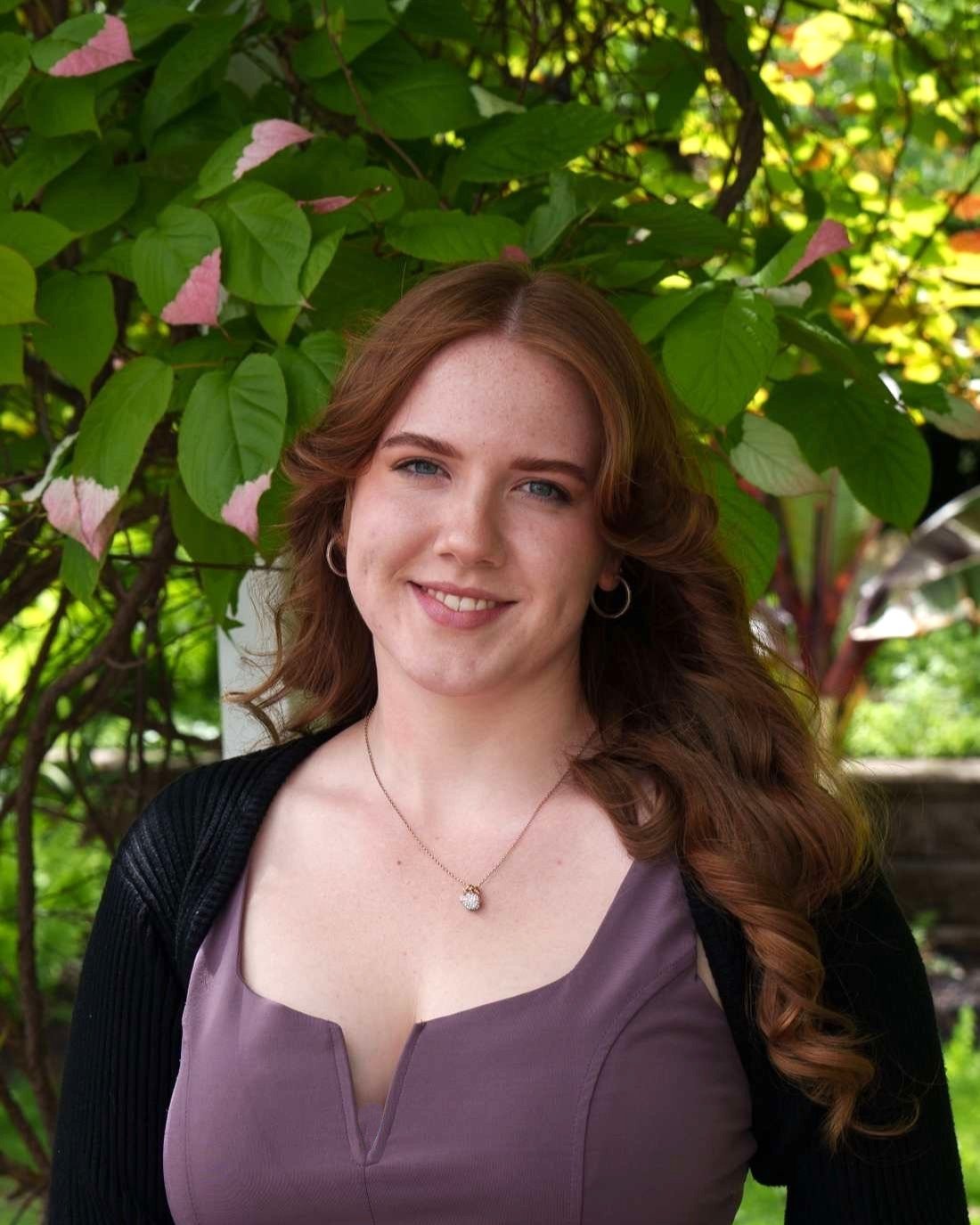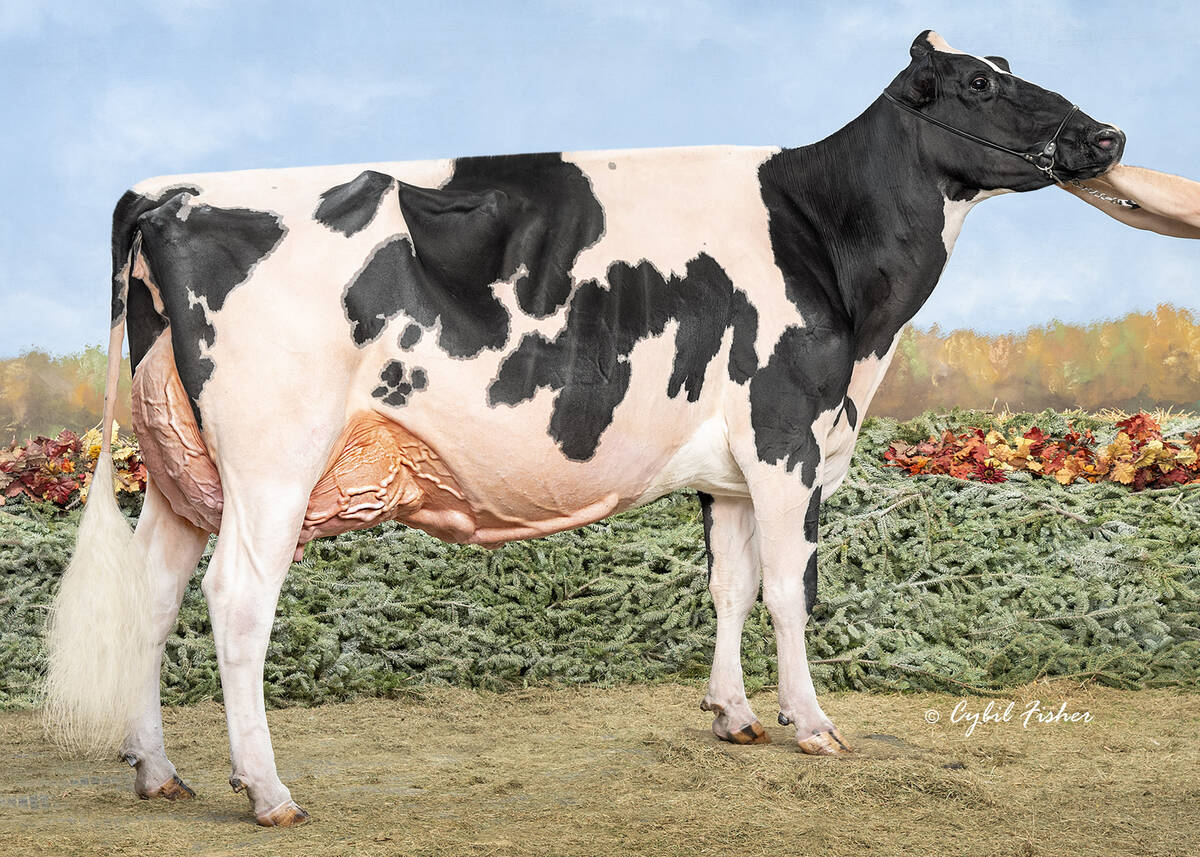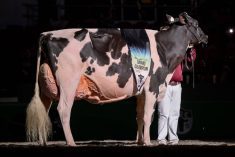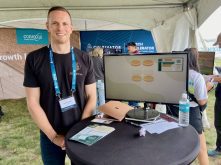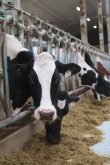A Saskatchewan bred cow made history at the 2025 World Dairy Expo in Madison, Wisconsin, when she was named grand champion in the five-year-old Holstein class.
Lovhill Sidekick Kandy Cane was born and bred in Balgonie, Sask., by Lovholm Holsteins before being sold as a four-year-old to the New York dairy operation Oakfield Corners, which showed her at Expo. This win makes the Lovhill prefix the first to win Holstein female grand champion twice at Expo.
The first win for the name was in 2015 with Lovhill Goldwyn Katrysha, bred by Lovholm and owned by MilkSource Genetics from Wisconsin. Katrysha was the sister of Kandy Cane’s grand dam, and other family members have also been shown and placed well.
Read Also

Selenium not deal breaker in coal mining: expert
Environmental scientist weighs in on coal mining debates in Western Canada, explaining selenium and the technologies and practices to lower its concentrations in nearby waterways to coal mining operations
Michael and Jessica Lovich, owner-operators of Lovholm Holsteins, described the family line as “consistent.” Kandy Cane’s two-year-old daughter won at a show in Alberta this past spring.
“They’re not always champion cows, but they’re just consistent farm cows,” said Jessica.
“They produce milk, fairly healthy, and they’re pretty, so, fairly consistent breeding through that line.”
Kandy Cane herself boasts balance and perfection, with silky skin, open ribs, clean head and neck, a strong set of feet and legs, and a “very dairy” look.
The Lovichs are proud of Kandy Cane’s win.
“You always have in the back of your mind she could do well (at Expo),” said Michael.
“But doing well could be third, could be second. Like, it’s such a deep field of cows there, that are unbelievable. And to say the week going into it, ‘I got the one that can win it all,’ you never want to jinx yourself.”
The Lovichs had been invited by Jonathon and Alicia Lamb, owner-operators of Oakfield Corners, to attend Expo and see Kandy Cane enter the ring. Michael attended, while Jessica stayed back to look after the farm.
The Lambs were confident that the Holstein would place well because Kandy Cane had proven herself over the last year, earning the titles of grand and supreme champion at the Eastern National in Harrisburg, Pennsylvania, in fall 2024 and grand champion at the Northeast Spring National this past March.
But they weren’t expecting this, saying it still feels “a bit surreal.”
The five-year-old Holstein class was the one bringing the buzz that day, with 16 cows in the competition. Alicia described the field as “a lot of one-name cows,” with many focused on Jeffrey-Way Hard Rock Twigs and Glenirvine UnixSally.
Alicia was near the entry to the ring, while Jonathon was in the stands, and it was like a scene from a movie. Those around her didn’t realize who she was as they made comments to each other about the cows, including Kandy Cane. She was able to hear honest opinions, which she really enjoyed.
“Everybody was talking about two other cows, Twigs and Sally. And it was kind of funny, as Kandy Cane walked in the ring, and people are looking, and they’re like,’well, who’s that cow there?’ ” she said.
“And they look in their sheet, and they say, ‘oh, that’s that cow from Oakfield. She looks really good.’ So, you could feel like a little bit of momentum shifting, and you knew that it was going to come down to those three cows. It was just the opinion of the judge that day as to which one he preferred, and we ended up being the one he preferred.”
Twigs ended up second, while Sally placed third.
Journey to grand champion
Kandy Cane was part of Lovholm Holsteins’ purebred herd, which originally began in Alberta.
The Lovhill name was started in 1978 by Michael’s parents and came with the Lovichs in 2015 when they moved east to Balgonie, bringing the herd along. They run a smaller dairy, milking 72 cows, all of which are purebred Holsteins.
Their operation isn’t very modernized, Jessica said, because of limited funds when they started. They rely heavily on their team of employees, neighbours, veterinarians and the dairy community.
The heifers are raised on pasture, and they try to put as much young stock out as they can, but it’s a challenge to get the land itself.
Their main philosophy is to put in the necessary time and effort to develop a strong cow.
“Our vision is to breed functional cows that can last, you know, have good longevity, good production and can go to anyone’s barn and do well,” Jessica said.
“And so, I think I’m speaking for Michael here, but his breeding goal is to just have those functional cows that have all the correct parts in the right places. And then from there, you can match your breedings as good as you can get them to.”
Michael started breeding cows at 14 — with some guidance and mentorship — and has been the primary decision maker on breeding for the farm ever since. He started to show an interest in it as a teen, and that interest never waned.
Now, he’s been working on involving his daughters in the breeding decisions. He asks them questions like what they think the cow needs, how they’d correct something in the next generation and what traits they think should be brought in.
“There’s always room for improvement on the cows,” he said.
“To say you got the perfect one, not very often. Like you can have good ones and really good ones, but there’s always room for improvement.”
Jessica had grown up showing cows, and since getting married, she and Michael have shown cows together across Western Canada. Last year, she showed Kandy Cane at the Western Dairy Expo in Saskatoon, where she won her class.
They don’t currently show at events such as the Royal Winter Fair or Expo, mostly because of the cost and time, which they don’t have enough to spare right now. However, going the distance is in the future plans.
Even now, when they show, Michael usually stays home because of the need to manage the farm and its work.
Exchange of the champion
In 2022, the Lambs came up to Saskatchewan for the Canadian National Holstein Convention and toured the Lovichs’ operation. After hearing of Kandy Cane’s win in Saskatoon, they asked the Lovichs about her.
“When we bought her, we made the decision that we couldn’t really skimp the trucking bill,” Jonathon said.
“Because if she came in not very good shape, then we were going to lose a year on her.”
Going from Balgonie, Sask. ,to Oakfield, N.Y., was a long drive for the prized cow. From Balgonie to the U.S. border, Michael Lovich was her chauffeur. She was then passed along to a trucker to take her to Wisconsin, and another picked her up from there for the final leg to her new home.
“When she got off the truck, she was tired, and I think she was happy not to be travelling anymore, but she was able to bounce back and come back around,” Jonathan said.
“But obviously it’s really important that they get a good truck ride, because if not, then it would have set it back a year.”
Her total ride was around 24 hours, and her journey cost the Lambs several thousand dollars, which Jonathon says is all part of the cost when you want an animal like that.
The Lambs run an intensive genetics and show program, having entered an intense level of showing around 20 years ago. The genetics side, which includes IVF, mating, selling and marketing, has been operating for 25 years.
They have a separately managed show barn that houses 28 cows. The barn is 14 pens, with two cows per pen and room to move, and it has a four-stall step-up parlour. The cows are managed similarly to other show operations and are fed corn silage, textured feed and dry hay, all to stay in year-round show condition.
Kandy Cane is done showing for the year because she’s due to calve in March.
The Lambs have been fielding many inquiries about calves and genetics, saying they’ve IVF’ed her a few times this year.
“There’s not a lot directly from her,” said Alicia.
“We will be selling one or two, our sale is in the spring, in March. But, yeah, opportunities are pretty limited from Kandy Cane right now.”

